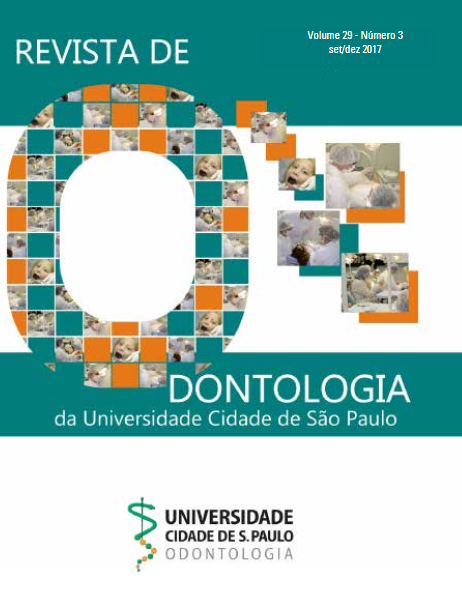Caracterización clínica, imagenológica y quirúrgica de la perforación discal en pacientes con disfunción de la articulación temporomandibular. Estudio de serie de casos
DOI:
https://doi.org/10.26843/ro_unicidv2932017p260-267Palavras-chave:
Articulación temporomandibular, Espectroscopía de resonancia magnética, Síndrome de la disfunción de articulación temporomandibularResumo
Introducción: La perforación discal (PD) del disco articular de la articulación temporomandibular (ATM) consiste en la rotura parcial o total del disco, pudiendo ocurrir en cualquier parte del mismo, siendo que en general, se considera como un signo de osteoartritis avanzada. Objetivo: El propósito del presente trabajo fue caracterizar clínica, imagenológica y quirúrgicamente la PD en una serie de casos con disfunción temporomandibular. Metodología: Se realizó un estudio retrospectivo de historias clínicas de pacientes atendidos entre 2013-016, con diagnóstico de disfunción de la ATM en etapas de Wilkes IV y V. Se seleccionaron aquellos con diagnóstico en resonancia magnética (RM) de PD, sometidos a cirugía abierta de ATM. Resultados: Se encontraron cinco casos en el periodo estudiado correspondiendo a 10 articulaciones. La totalidad de los pacientes fueron mujeres con edad promedio de 49 años, refirieron algún tipo de dolor y presencia de ruido articular con apertura bucal
Downloads
Referências
Kuribayashi A, Okochi K, Kobayashi K, Kurabayashi T. MRI findings of temporomandibular joints with disk perforation. Oral surgery, oral medicine, oral pathology, oral radiology, and endodontics. 2008;106(3):419-25. Monje Gil F. Diagnóstico y tratamiento de la patolología de la articulación temporomandibular. Madrid: Ripano; 2009. Liu XM, Zhang SY, Yang C, Chen MJ, X YC, Haddad MS, et al. Correlation between disc displacements and locations of disc perforation in the temporomandibular joint. Dento maxillo facial radiology. 2010; 39(3):149-56. Embree MC, Iwaoka GM, Kong D, Martin BN, Patel RK, Lee AH, et al. Soft tissue ossification and condylar cartilage degeneration following TMJ disc perforation in a rabbit pilot study. Osteoarthritis and cartilage. 2015; 23(4):629-39. Yura S, Nobata K, Shima T. Diagnostic accuracy of fat-saturated T2-weighted magnetic resonance imaging in the diagnosis of perforation of the articular disc of the temporomandibular joint. The British journal of oral & maxillofacial surgery. 2012; 50(4):365-8. Holmlund AB, Axelsson S. Temporomandibular arthropathy: correlation between clinical signs and symptoms and arthroscopic findings. International journal of oral and maxillofacial surgery. 1996; 25(3):178-81. Shen P, Huo L, Zhang SY, Yang C, Cai XY, Liu XM. Magnetic resonance imaging applied to the diagnosis of perforation of the temporomandibular joint. Journal of cranio-maxillo-facial surgery: official publication of the European Association for Cranio-Maxillo-Facial Surgery. 2014;42(6):874-8. Ferreira LA, Grossmann E, Januzzi E, de Paula MV, Carvalho AC. Diagnosis of temporomandibular joint disorders: indication of imaging exams. Brazilian journal of otorhinolaryngology. 2016;82(3):341-52. Xu Y, Zhan J, Zheng Y, Han Y, Zhang Z, Xi Y, et al. Synovial fluid dynamics with small disc perforation in temporomandibular joint. Journal of oral rehabilitation. 2012; 39(10):719-26. Murakami K. Rationale of arthroscopic surgery of the temporomandibular joint. Journal of oral biology and craniofacial research. 2013; 3(3):126-34. Machon V, Sedy J, Klima K, Hirjak D, Foltan R. Arthroscopic lysis and lavage in patients with temporomandibular anterior disc displacement without reduction. International journal of oral and maxillofacial surgery. 2012; 41(1):109- 13. Wilkes CH. Internal derangements of the temporomandibular joint. Pathological variations. Archives of otolaryngology--head & neck surgery. 1989; 115(4):469-77. Widmalm SE, Westesson PL, Kim IK, Pereira FJ, Jr., Lundh H, Tasaki MM. Temporomandibular joint pathosis related to sex, age, and dentition in autopsy material. Oral surgery, oral medicine, and oral pathology. 1994; 78(4):416-25. Silveira AM, Feltrin PP, Zanetti RV, Mautoni MC. Prevalência de portadores de DTM em pacientes avaliados no setor de otorrinolaringologia. Revista Brasileira de Otorrinolaringologia. 2007;73(4):528-32. Becker I. Oclusión en la práctica clínica. 2 ed. Caracas: Amolca; 2012. Stratmann U, Schaarschmidt K, Santamaria P. Morphometric investigation of condylar cartilage and disc thickness in the human temporomandibular joint: significance for the definition of ostearthrotic changes. Journal of oral pathology & medicine : official publication of the International Association of Oral Pathologists and the American Academy of Oral Pathology. 1996;25(5):200-5.

